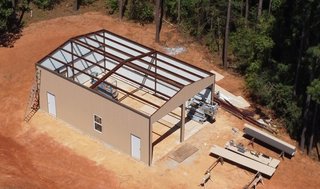Metal buildings are known for their strength, affordability, and fast construction timelines. But the success of the metal building project largely is determined by how well cellular phone process is planned and executed. Whether you're generating a small backyard workshop or even a large industrial warehouse, learning the Barndominium installation process will help save time, money, and get away from costly mistakes.

What Is Metal Building Installation?
Metal building installation refers back to the process of assembling a prefabricated metal structure on-site. These structures are generally delivered in kits, full of all necessary components—steel frames, panels, fasteners, and instructions. Installation can be carried out by professional crews or, for smaller buildings, by experienced DIYers.
Step-by-Step Metal Building Installation Process
1. Site Preparation
Before the initial piece of metal is assembled, the building site needs to be properly prepared:
Clear and level the ground
Excavate and pour the foundation or concrete slab (according to your building's design)
Ensure proper drainage and access to utilities if needed
2. Inventory and Inspection
Once your metal building kit arrives, check all materials up against the packing list. Look for missing or damaged components before starting the build.
3. Anchor Bolt Placement
Anchor bolts take hold in the concrete foundation and serve as the tie-down points to the building’s frame. It’s essential they are placed accurately, as errors can impact the entire structure.
4. Frame Assembly
This is the place your building actually starts to take shape. Install the key vertical columns first, followed by the roof rafters. Bolted connections are normally used to attach structural components.
Use proper equipment like scaffolding or cranes for larger buildings
Always stick to the manufacturer’s diagrams and torque requirements
5. Secondary Framing Installation
Add girts, purlins, along with other secondary framing components that secure the walls and roof. This step helps as well square the structure and improve its rigidity.
6. Roof and Wall Panel Installation
Attach the metal panels to the frame, beginning from one corner and working your way across. Be sure to:
Overlap panels according to instructions
Use weather-resistant screws or fasteners
Install vapor barriers or insulation if required
7. Doors, Windows, and Trim
Install roll-up or walk doors, windows, and then any other accessories. Finish by making use of trim pieces to offer the building a clean, sealed, and professional appearance.
8. Final Inspection and Cleanup
Double-check all fasteners, ensure structural components are tightened and aligned, and make sure all protective coatings are intact. Clear the site of debris and construction waste.
Safety First
Metal building installation involves heavy materials, tools, and quite often working at heights. Always prioritize safety:
Wear proper PPE (gloves, boots, helmets)
Follow OSHA regulations or local safety codes
Don’t attempt large-scale installations without professional help
DIY or Hire a Pro?
Smaller metal buildings, like garages or sheds, are frequently assembled by capable DIYers with a few helpers. Larger, more advanced projects—like barns, commercial buildings, or aircraft hangars—should often be handled by experienced contractors to make certain compliance with local codes and structural integrity.
Final Thoughts
Installing a metal building can be a cost-effective and efficient method to add space for storage, work, or business. With proper planning, accurate execution, as well as a strong target safety, your metal building might be installed quickly and last for decades.
